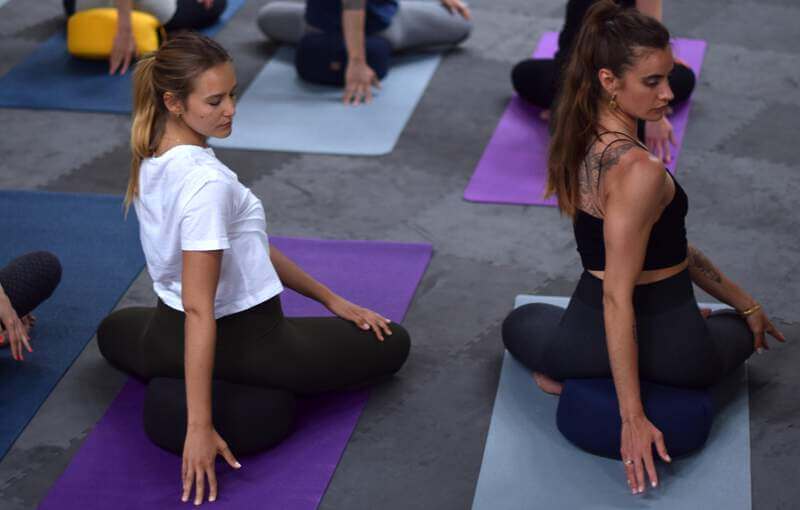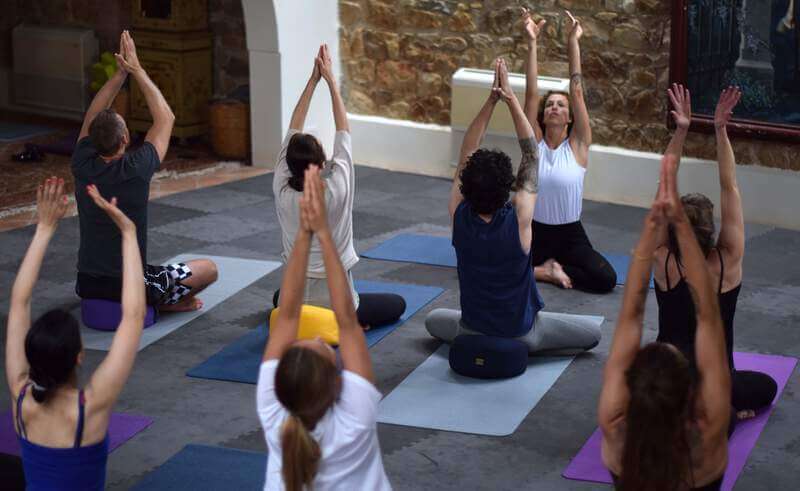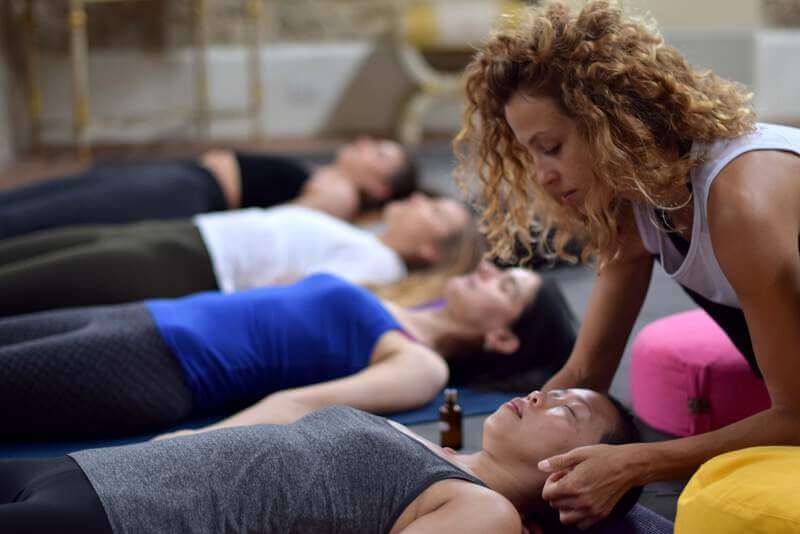As yoga teachers we want to offer our students safe, effective and healthy classes. We want to guide them deep into the practice, see them connect with their innermost self and have a nourishing and transformative experience. Most of us became yoga teachers, because we once had this kind of experience!
When we create unique yoga classes that go beyond the physical, we build a bridge between the practice on the mat and daily life, giving our students a deeper understanding of the meaning of yoga. Including themes and dedicating our practice to qualities and virtues that we would like to cultivate, we nurture our body and our mind, improving mental, emotional and physical wellbeing.
Sometimes it can be hard to stay inspired and repeatedly come up with stimulating themes - whether you have just completed your first teacher training, you teach one class a week or manage a full schedule of classes. This is why I collected 50 of my favorite class themes, for you to spark your creativity and keep it interesting for yourself and your students.
Setting yourself apart through meaningful and well-thought-out sequences can also help fill up your classes and create real relationships with your yogis. Of course, it is up to you how much of your chosen theme you share with your students. You can discuss it in class or simply use it to give your class a sensible structure and as a way to keep yourself inspired and excited about teaching.
Read on for some of my favorite class themes and focuses. I hope they give you some inspiration!

Intention Based classes
1. Open Your Heart And Cultivate Gratitude. Focus on heart opening poses and movements and expansion of breath. Inspire your students to be accepting to the very moment and their feelings and offer positive affirmations.
2. Let Go Of Whatever You Don’t Need Anymore. Focus on tension relief for hips, shoulders, neck and jaw. Encourage your students to notice their thought patterns and to let them come and go without identifying with them.
3. Find Your Inner Strength. Stimulate the core and build up stability from the inside with Bandhas. Support your students to cultivate a sense of security and trust from the inside out rather than focusing on physical performance.
4. Dedicate Your Practice To Someone Else. Selfless giving is a yogic aspiration. Offer students to dedicate their practice to someone or a group of people who need healing energy, compassion and love.
5. Forgive The Past. Focus on heart opening, stimulate the throat area and offer guided meditation. Be careful not to trigger sensitive topics, but rather focus on a general sense of softness and surrender.
6. Focus On Yourself. Encourage the students to draw the attention inside and focus on feeling rather than seeing. You can offer to practice with closed eyes when suitable.
7. Be Present. Make the awareness of breath the main focus of the class, in meditation and in posture and movement using it as the ultimate tool to transport students back into the present moment.
8. Acceptance and Self-Love. Invite your students to practice non-attachment and not evaluate their practice. Instead ask them to express gratitude for their body just as it is in this very moment.
9. Play Your Edge. Challenge your students to consciously explore their comfort zone and encourage them to evaluate and softly expand their boundaries.
10. Be Yourself, Chose Yourself. Encourage your students to claim themselves and chose every step in their practice consciously. Ask them to add on or leave out at each step of the practice being entirely honest with themselves and their current needs.
Chakra Related Class Themes
11. Muladhara - Root Chakra: Root To Rise. Build poses from the ground up, cultivating a feeling of stability. Focus on the feet, legs, pelvic area; strong standing poses, poses with floor contact, forward folds.
12. Svadhistana - Sacral Chakra: Go With The Flow Of Life. Offer fluid sequences and encourage students to notice where they flow more or less easily and where they hold tension. Encourage creative expression to free imbalances in the body. Focus on poses that stimulate the hips and pelvic area.
13. Manipura - Solar Plexus: Know Your Power. Create warmth and inner strength with core focused exercises, Kapalbhati, forward folds and twists. Stronger poses train our stamina and drive, giving us confidence and trust.
14. Anahata - Heart Chakra: Free Yourself, Chose Joy. Our heart center symbolizes awareness and manifestation of love, affection, compassion and acceptance. Focus on expanding the breath, cultivating prana and heart opening poses.
15. Vishuddha - Throat Chakra: Express yourself, Speak Your Truth. Bring awareness to the throat and neck with poses such as Salamba Sarvangasana (Supported Shoulder Stand), Halasana (Plow) and Matsyasana (Fish) and others that release this area. Include breathe exercises such as Lions Breath and Ujjayi breath.
16. Ajna - Third Eye Chakra: See With Your Soul. Encourage an intuitive approach to the practice and the poses. With Alternate Nostril Breathing (Nadi Shodana) and practicing asana with heightened awareness you can lead your students into a meditative state and exploration of their own consciousness.
17. Sahasrara - Crown Chakra: Connect To Your Higher Self. Focus on balancing and uniting the masculine and feminine forces, Shiva and Shakti, by encouraging your students to notice which side of the body experiences more dominance, ease, sensation or flexibility. Pranyama and inverted poses can help directing the energy in the body and reaching a higher sense of awareness.

Time Of Day And Seasonal Inspiration
18. Morning Glory. Start your day fresh and activate your energies. Focus on breath work and twists to stimulate the metabolism and sun salutations to warm and energize the body and mind.
19. Lunch Reboot. Re-set, rest and energize for the second half of the day. Find a balance between resting and energizing poses and exercises in order to re-energize students rather than exhausting them.
20. Evening Release. Wind down and leave the day behind. Focus on tension relieving postures, forward folds, soft chest and shoulder opening, meditation.
21. Spring: Renewal and Radiance. Focus on breath expansion, heart opening and loosening up the tensions from the winter. Like the soil that needs loosening before planting your seeds, we prepare to set our intentions for the new season.
22. Summer: Beat The Heat. In times of power and warmth we can challenge the body according to the season with faster sun salutations and invigorating practices and flows. Depending on temperatures include cooling and calming practices!
23. Autumn: Let Your Leaves Fall. Focus on poses that stimulate letting go of old energies and tension and strengthen the immune system in preparation for the colder months.
24. Winter: Get Fired Up. Create inner heat and energy to counter the sluggish and demotivated tendencies of winter.
Yogic Philosophy Inspired
25. Sthira-sukham âsanam - A yoga posture should be steady, firm and stable, yet also comfortable and light (Patanjali Yoga Sutra 2.46). Remind students of these qualities throughout asana practice aiming for a balance in body and mind.
26. Yogas citta-vrtti-nirodhah - Yoga is the stilling of the agitations of the mind ( Patanjali Yoga Sutra 1.2). Encourage students to become the seer of their own mind through the practice of yoga, encourage observation and detachment of thoughts.
27. Ahimsa (Non-harming). Inspire students to not push themselves, but instead listen to the body.
28. Satya (Truthfulness). Invite students to asses themselves honestly and not pretend in poses in favor of performance.
29. Aparigraha (Non-attachment). Inspire students to be focused only on their own practice, not compare with others and free themselves of expectations and judgement.
30. Sauca (Purity of body and mind). Even the conscious set up and cleaning of our yoga mat and props can be an act of mindfulness and can be a conscious part of the practice.
31. Samtosha (Attitude of contentment). Guide students to a peaceful feeling of contentment by reminding and inspiring them to be accepting towards what they have attained and what is at the moment.
32. Svadhyaya (Self-study and reflection). Asana practice becomes more than a physical exercise through inner reflection. Invite students to become aware of the inner changes that their practice stimulates.

Physically Oriented Classes
33. Back Bends. Offer a sustainable practice for your students by thoroughly stretching across the entire front body while taking care of lower back and neck compression.
34. Hip Opening. Support your students in developing a healthy range of motion of the hips with seated, supine and prone postures. Take extra care of the knees and back.
35. Twisting & Core Awakening. Add active and passive twists to standing, sitting and supine poses. Incorporate exercises to strengthen and stimulate the core yet keeping it supple and free of tension.
36. Forward Bends. Explore different forward bending postures reminding you students that these are calming poses, that should softly open up the backside of the body.
37. Inversions. Safely guide your students into the upside-down world step by step. Make it fun to work with partners, props or the wall for beginner to intermediate levels.
38. Standing Balances. Include powerfully grounding practices and core strengthening exercises working up to balancing poses and joyful expression. Keep it playful!
39. Arm Balances. Offer preparatory poses and several steps up to the fully balanced poses. Remember to keep it playful and work with your students fear of falling. Remember to take care of wrist health.
Other Ways To Inspire And Structure Your Classes
40. Focus of the Week. Set a focus of the week or month to move deeper into one topic or aspect of the practice or a specific pose or flow.
41.Students Preferences. Ask for your students wishes and include them in your next classes.
42. Intention Cards. Draw a minduflness or intention card or offer your students to do so and keep them visible during their practice.
43. Motivational Quotes. Focus on inspiring and and motivational messages that you read for opening or closing of the class or to come back to as a foundation throughout the class.
44. Level of Experience. Focus on different levels from beginner to advanced or a specific target group such as seniors, pregnant women or practicioners with certain restrictions.
45. Mantras and Affirmations. Use mantras that complement the poses or the intention of your class. This works especially well in yin and restorative classes as it also gives the student’s mind something to focus on.
46. Specific Qualities. Underlying aim of the class could be a quality such as softness and relaxation, power and stimulation, creating warmth, cooling down, steadiness, ease, balance, stability, flow.
47. Health and Well-being. Focus on back pain, joint health, spinal health or immune system support (please make sure you hold the required qualification!).
48.Play Music. Create a playlist to support the rhythm of breath and movement. Pick your music carefully so it doesn’t become a distraction but rather carries your students into the practice with more ease.
49. Magical Atmosphere. Use candle light, incense, essential oils or a particular set up of the room such as a mandala circle with yoga mats to create a special expereince.
50. Sound and Vibration. Use singing bowls, Cchimes or chants making your class an immersive and unique experience.